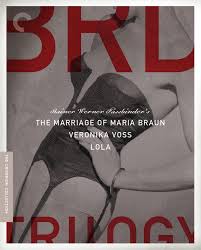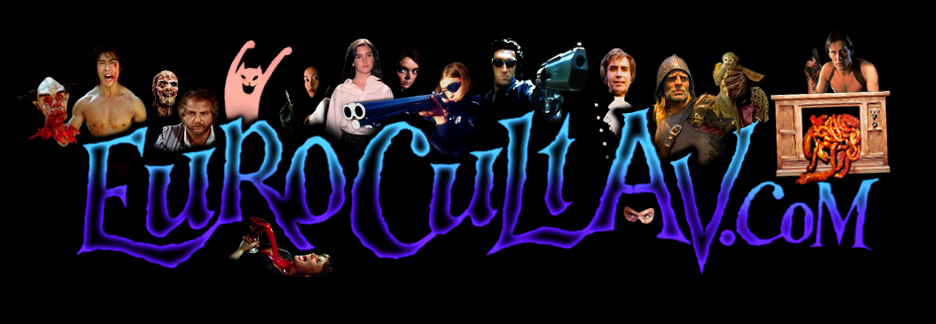BRD Trilogy
Director- R.W. Fassbinder
Cast- Various
Country of Origin- Germany
Distributor - Criterion
Number of discs – 3
Reviewed by - Scott MacDonald
Date- 08/06/2019

When I first started collecting Criterion's output on DVD in the early 2000's, I had a tendency to grab at box sets. I was a young film student, making just above minimum wage in a bookstore, and could rarely afford the premium Criterion titles I wanted. When I did my logic was that box sets offered more value in one shot, 3 films for 50 ,instead of one for maybe 30. This is how my first films by Bergman ended up being his Silence of God trilogy, rather than say the Seventh Seal, and in that same regard it is also how I came to R.W. Fassbinder through his BRD Trilogy which Criterion is unleashing this month on Blu-ray.
BRD stands for Bundesrepublik Deutschland, which was the name for West Germany in the post-war period. The film was Fassbinder's response to the so-called German economic miracle of the 1950's, and how the recent past had all but been forgotten in the wake of the current prosperity. The trilogy tells the story of 3 women in that period, and how their lives are affected by the conflict.
The first, and quite possibly the best of the 3 is the Marriage of Maria Braun, which was a huge hit in Germany upon it's 1979 release. The film was highly influenced by Douglas Sirk, who was a cinematic idol to Fassbinder. The Marriage of Maria Braun follows the titular Maria Braun. The film opens on the day she is married to her husband Hermann. He is promptly sent out to war, and soon reported dead. This causes Maria Braun (played perfectly by Hanna Schygulla) to make her living in this than reputable ways.
She starts working in a club, amongst other things. One day he returns from a Russian encampment, and rather then put their lives in order we find that he immediately gets blamed for a crime and sent to prison sending Maria to continue finding success in less than legal ways.
I've seen Marriage of Maria Braun a number of times through the years, and this one never ceases to floor me. For a director who shot multiple films a year, Fassbinder had an ability to inject beauty in the rawness of his films. Further, the performances are absolutely stunning. Colors here are excellent, and the whole thing is a massive bit of cinematic perfection.
The second part of the trilogy though released last is Veronika Voss. Veronika Voss has a very Billy Wilder, Sunset Boulevard quality to it. The film follows Veronika Voss in 1955, a decade prior she was the highlight of German cinema, but like Sunset Boulevard's Norma Desmond she has long been forgotten. Of course, she does not realize she's been forgotten, and acts as if the world is waiting for her, and studios as far away as the U.S. want to bring her over to star in their pictures. Aside from her lack of fame, Veronika finds herself being treated in a psychiatric clinic run by Dr. Katz. It turns out that Katz is chemically manipulating his patients by getting them addicted to morphine, and having them sign their lives away for treatment. A writer who becomes obsessed with Veronika dives in with his girlfriend to investigate Katz.
Veronika Voss is not the best Fassbinder film ever made, but it is a strong drama, with powerful characterizations that manage to draw the viewer in, and not let them go. The story is based on the true story of actor Sybille Schmitz, but at the same time feels like Fassbinder's take on the aforementioned Wilder film. The film is shot in crisp and gorgeous black and white, which helps to channel the period and tone quite well.
The third film of the trilogy and second one shot is 1981's Lola. Lola, like Voss is set in the mid-1950's during the post-war economic boom. It follows a man named Von Bohm who moves to a new town to become their building commissioner. The people who run the town are hoping to manipulate him in order to make money from construction, Von Bohm, however is a moral person, and puts down their plans. At the same time Von Bohm meets Lola, a cold and calculated young woman who happens to work in a brothel in the town, and who manipulates men for her own needs. Von Bohm looks at Lola as a woman to marry, and live a moral existence with. Lola, does not return the same emotions, and rather looks at Von Bohm as the latest man who has a wallet she can manipulate.
Lola might be the most over-the-top gorgeous film of the trilogy. The film is bathed in unnatural light by the way of Dario Argento or Mario Bava. Rather, than a simple stylistic decision, he uses it to depict the tone of various scenes or moods of the characters. As per Fassbinder's usual the performances in the film are dramatic morphine, they lull the viewer in and never let's them go.
The BRD Trilogy is presented in 2 separate aspect ratios, Voss is presented 1:78:1 while Lola and Maria Braun are presented at 1:66:1 these are new 1080p restorations for the 3 films with new 4k restores for Maria Braun and Lola. All 3 films look truly stunning the color in Maria Braun looks natural, and well-reproduced. The Colors in Lola POP from the screen, and the crisp black and white cinematography of Veronika Voss is well-reflected here. Audio is handled by LPCM 1.0 tracks in German that sound quite solid, and without issues. Extras include commentary tracks on all 3 films, interviews, documentaries and so much more. The BRD Trilogy is another stunning achievement in the career of R.W. Fassbinder, and the restoration by Criterion makes this one easy to HIGHLY RECOMMEND.






